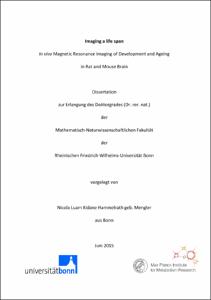Hammelrath, Nicola Luam Kidane: Imaging a life span : In vivo Magnetic Resonance Imaging of Development and Ageing in Rat and Mouse Brain. - Bonn, 2016. - Dissertation, Rheinische Friedrich-Wilhelms-Universität Bonn.
Online-Ausgabe in bonndoc: https://nbn-resolving.org/urn:nbn:de:hbz:5n-42269
Online-Ausgabe in bonndoc: https://nbn-resolving.org/urn:nbn:de:hbz:5n-42269
@phdthesis{handle:20.500.11811/6693,
urn: https://nbn-resolving.org/urn:nbn:de:hbz:5n-42269,
author = {{Nicola Luam Kidane Hammelrath}},
title = {Imaging a life span : In vivo Magnetic Resonance Imaging of Development and Ageing in Rat and Mouse Brain},
school = {Rheinische Friedrich-Wilhelms-Universität Bonn},
year = 2016,
month = jan,
note = {Rats and mice are the most abundantly used animal models in translational research. They are employed in the service of clinical research in the sense of establishing methods, testing therapeutic strategies and pharmacological interventions. Magnetic Resonance Imaging (MRI) has become the most important neuroimaging tool. It offers on the one hand absolute integrity of the tissue and thereby allowing multiple examinations of the same subject without confounding developmental processes and on the other hand effective exchange between bench and bedside, due to its high translational nature. Compared to the vastness of imaging studies in rodent models of neuropathological conditions, we know very little about the development of neuroimaging parameters over the life span of rats and mice. One of the major challenges in a longitudinal imaging study is the data handling and post-processing. In order to assure reliability and reproducibility of the results, the first goal of this thesis was to establish a post processing protocol and designed a graphical user interface. This allowed for robust analysis of the MRI data and for fast visual inspection of the registration success. In the second step, the presented studies established a time profile of the most widely used MRI parameters for cerebral development in mice and rats. This will help neuropathological studies to set a reasonable age threshold, avoiding maturation processes to potentially obliterate the therapeutical effect. Thirdly, a longitudinal study in rats was conducted, searching for translational biomarkers of cerebral ageing. A multimodal approach was chosen, employing not only structural MRI but also the most prevalent fMRI and PET markers. Calorie restriction and appropriate housing conditions led the rats to age healthy, without age-related diseases. The results demonstrate a rather heterogeneous ageing process across different parameters and cerebral GM regions. This is in strong contrast to the rather synchronized maturation processes but reflects the human situation during healthy ageing.
Our work created a baseline on structural MRI parameters, describing periods of life marked by immense structural reorganisation. The results will help future studies on pathologies in the adolescent or ageing brain and has helped defining the starting point of stable adulthood},
url = {https://hdl.handle.net/20.500.11811/6693}
}
urn: https://nbn-resolving.org/urn:nbn:de:hbz:5n-42269,
author = {{Nicola Luam Kidane Hammelrath}},
title = {Imaging a life span : In vivo Magnetic Resonance Imaging of Development and Ageing in Rat and Mouse Brain},
school = {Rheinische Friedrich-Wilhelms-Universität Bonn},
year = 2016,
month = jan,
note = {Rats and mice are the most abundantly used animal models in translational research. They are employed in the service of clinical research in the sense of establishing methods, testing therapeutic strategies and pharmacological interventions. Magnetic Resonance Imaging (MRI) has become the most important neuroimaging tool. It offers on the one hand absolute integrity of the tissue and thereby allowing multiple examinations of the same subject without confounding developmental processes and on the other hand effective exchange between bench and bedside, due to its high translational nature. Compared to the vastness of imaging studies in rodent models of neuropathological conditions, we know very little about the development of neuroimaging parameters over the life span of rats and mice. One of the major challenges in a longitudinal imaging study is the data handling and post-processing. In order to assure reliability and reproducibility of the results, the first goal of this thesis was to establish a post processing protocol and designed a graphical user interface. This allowed for robust analysis of the MRI data and for fast visual inspection of the registration success. In the second step, the presented studies established a time profile of the most widely used MRI parameters for cerebral development in mice and rats. This will help neuropathological studies to set a reasonable age threshold, avoiding maturation processes to potentially obliterate the therapeutical effect. Thirdly, a longitudinal study in rats was conducted, searching for translational biomarkers of cerebral ageing. A multimodal approach was chosen, employing not only structural MRI but also the most prevalent fMRI and PET markers. Calorie restriction and appropriate housing conditions led the rats to age healthy, without age-related diseases. The results demonstrate a rather heterogeneous ageing process across different parameters and cerebral GM regions. This is in strong contrast to the rather synchronized maturation processes but reflects the human situation during healthy ageing.
Our work created a baseline on structural MRI parameters, describing periods of life marked by immense structural reorganisation. The results will help future studies on pathologies in the adolescent or ageing brain and has helped defining the starting point of stable adulthood},
url = {https://hdl.handle.net/20.500.11811/6693}
}






